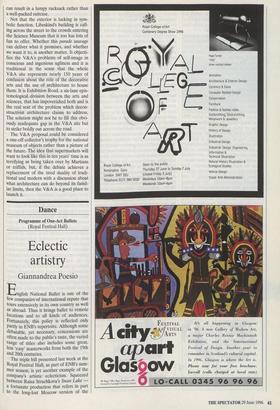Dance
Eclectic artistry
Giannandrea Poesio
English National Ballet is one of the few companies -of international repute that tours extensively in its own country as well as abroad. Thus it brings ballet to remote locations and to all kinds of audiences. Fortunately, this policy is reflected only partly in ENB's repertoire. Although some debatable, yet necessary, concessions are often made to the public's taste, the varied range of titles also includes some great, less 'easy' masterworks from both the 19th and 20th centuries.
The triple bill presented last week at the Royal Festival Hall, as part of ENB's sum- mer season, is yet another example of the company's artistic eclecticism. Squeezed between Raisa Struchkova's Swan Lake a fortunate production that refers in part to the long-lost Moscow version of the classic by Alexander Gorsky — and Michael Corder's Cinderella — which has become a favourite of many ballet-goers the mixed programme included works from different choreographic strands.
The scheduled opening piece, however, by Matthew Hart, the young British chore- ographer whose creations never fail to pro- voke all sorts of reactions, had to be cancelled because of an outbreak of injuries. It has been replaced by Patrick Lewis's Unrequited Moments. This is a bal- let which relies heavily on both the techni- cal skills and the artistic talent of the four interpreters — Lisa Pavane, Dimitri Gruzdyev, Monica Perego and Greg Hors- man — to explore the drama experienced by two sets of friends when one of the girls develops an obsessive attraction for the other girl's fiance.
I found the dramatic pretext rather flim- sy and trite, vitiated by a preposterous ren- dering of what, supposedly, should have been the gamut of intense but contrasting feelings, but in reality were a series of quirky grimaces. The movement vocabulary was also a little too reminiscent of Jiri Kylian's distinctive formulae, yet without the exhilarating inventiveness that charac- terises the work of the Czech master. Few members of the audience, however, seemed to have negative feelings about it and responded enthusiastically. Not surprising considering that most ballet-goers do not know much about Kylian, and that the stereotypical images of contrasting love affairs are the successful ingredients of the dominating soap-opera culture.
The television-like quality of the first work also characterised the second item in the programme, Encounters, which is choreographed by the celebrated skating champion Christopher Dean. While some of my eminent colleagues look down on this work, dismissing it as a purely commer- cial expedient, I cannot help finding it interesting, especially in terms of move- ment. Although the autobiographical con- tent, the lack of a proper choreographic structure, the flashy sets, the musical choice — Paul Simon's songs — and the intriguing costumes make this ballet very similar to one of those choreographic inser- tions that characterise the continental Sat- urday night television shows, there is a good sense of movement that confers a particular fluidity on the entire piece. Prob- ably this is not art, but it is certainly good entertainment.
The late 19th-century Grand Pas from the ballet Paquita, the concluding item in the programme, is sheer entertainment too. Conceived by the prolific choreographer Marius Petipa as a showcase for the bravu- ra of the Imperial Ballet, the Grand Pas is, in other words, pure circus on point shoes, an excellent example of utterly enjoyable 19th-century choreographic bad taste. As such it requires a great deal of artistry, as well as technique, in order to maintain its refined 'vulgar' panache and not to become excessively cheap and tasteless.
Unfortunately, the performance I attend- ed was everything but exciting. Although Derek Deane's staging derives mainly from the standard version performed worldwide, there are some structural oddities that do not make much sense. To have 'twelve ladies', as written in the cast sheet, inter- rupting the variations sequence, means to alter Petipa's perfect geometrical construc- tion of the work, which reflected the dis- tinctive hierarchical arrangement of the corps de ballet in the late 19th century. Being less important than the soloists and the two principals, the 12 ladies should come first (in ballet the VIPs always come last) thus introducing the subsequent solo dances.
The chosen six variations — Paquita is one of those mysterious ballets with hun- dreds of different solos borrowed from many other 19th-century works — did not respond to Petipa's stylistic canons either, for in his works a slow solo is generally fol- lowed or preceded by a fast, brilliant one, following a precise choreographic metre. The corps de ballet, moreover, lacked that precise coordination that is, or should be, another key element of Petipa's choreogra- phy.
Of the six solo dancers I saw, only the two principals, Agnes Oaks and Thomas Edur — who will soon join Birmingham Royal Ballet — seemed to have both the stylistic quality and the presence required for their roles, although their technique was anything but tidy. Pity, for one of Derek Deane's aims is to have a technical- ly flawless company.



























































 Previous page
Previous page